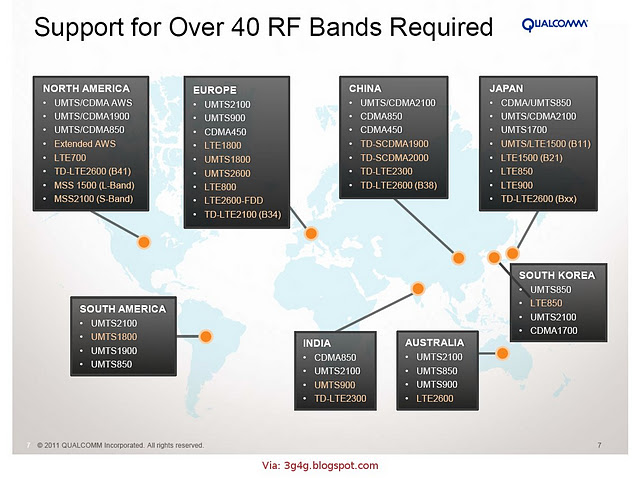The GSMA’s Wireless Intelligence has produced a report backing the Association’s strategic demand for increased spectrum harmonisation for mobile broadband services.
Wireless Intelligence ?forecasts that by 2015 there will be more than 200 live LTE networks ?using 38 spectrum frequency combinations. A Wireless Intelligence report also indicated that the global adoption of LTE services risks being hampered by device interoperability issues unless harmonised spectrum band plans can be achieved.
The report – Global LTE Network Forecasts and Assumptions – One Year On – predicts that there will be 38 different spectrum frequency combinations used in LTE deployments by 2015, a fragmented scenario fuelled by ongoing spectrum auctions, licence renewals and re-farming initiatives across a wide range of frequency bands. The lack of spectrum harmonisation represents a key challenge for the emerging LTE ecosystem, potentially preventing vendors from delivering globally compatible LTE products such as devices and chipsets, or requiring them to increase prices.
“Spectrum fragmentation has the potential to hinder global LTE roaming if device manufacturers are required to include support for many disparate frequencies in their devices,” said Wireless Intelligence senior analyst and report author Joss Gillet. “Given the backwards compatibility already required for either HSPA or EV-DO connectivity, we are unlikely to see a ‘world’ device in a handset form-factor soon.”
Wireless Intelligence forecasts that there will be more than 200 live LTE networks in over 70 countries by 2015, up from 40 networks in 24 countries today. The report notes that the IMT-extension band (2500/2600MHz) is the most globally harmonised band used in LTE deployments to date, accounting for over half of live networks in 2011.
Meanwhile, the number of LTE connections is forecast to grow from 7 million in 2011 to close to 300 million by 2015. More than two-thirds of global LTE connections today relate to deployments at 700MHz due to the large-scale rollouts underway in the United States (see chart). Asia Pacific has the most varied spectral combinations of all the global regions despite significant support for LTE at 2100MHz (Japan), 2500MHz (China) and 1800MHz (Southeast Asia). Asia Pacific, Africa and the Middle East will represent a joint 50% of global LTE connections by 2015, which further underlines the urgent need for spectrum harmonisation.
Spectrum fragmentation is set to increase over the next four years as more LTE networks are deployed in the digital dividend (700/800MHz) and re-farmed frequency bands. Among the 38 frequency combinations predicted by 2015, the 700/800MHz band is expected to be used in around a quarter of LTE network deployments, compared to approximately one-third for the IMT-extension band and one third using re-farmed spectrum.
“Spectrum re-farming will grow in importance as an interim solution as operators await additional spectrum to be allocated by governments and regulators,” said Gillet. “Our research indicates that one-third of LTE operators around the globe will be unable to secure any additional spectrum in the 700, 800, 2500 or 2600 MHz bands before 2016 at the earliest – which will further exacerbate data capacity issues and limit LTE coverage expansion plans.”
The new report Global LTE Network Forecasts and Assumptions – One Year On is available to Wireless Intelligence customers and select members of the media. For further information concerning this research, or to speak to a Wireless Intelligence analyst, please email info@wirelessintelligence.com.
(Picture is a Qualcomm slide shown at 4G World 2011. Via 3g4gblogspot.com)



